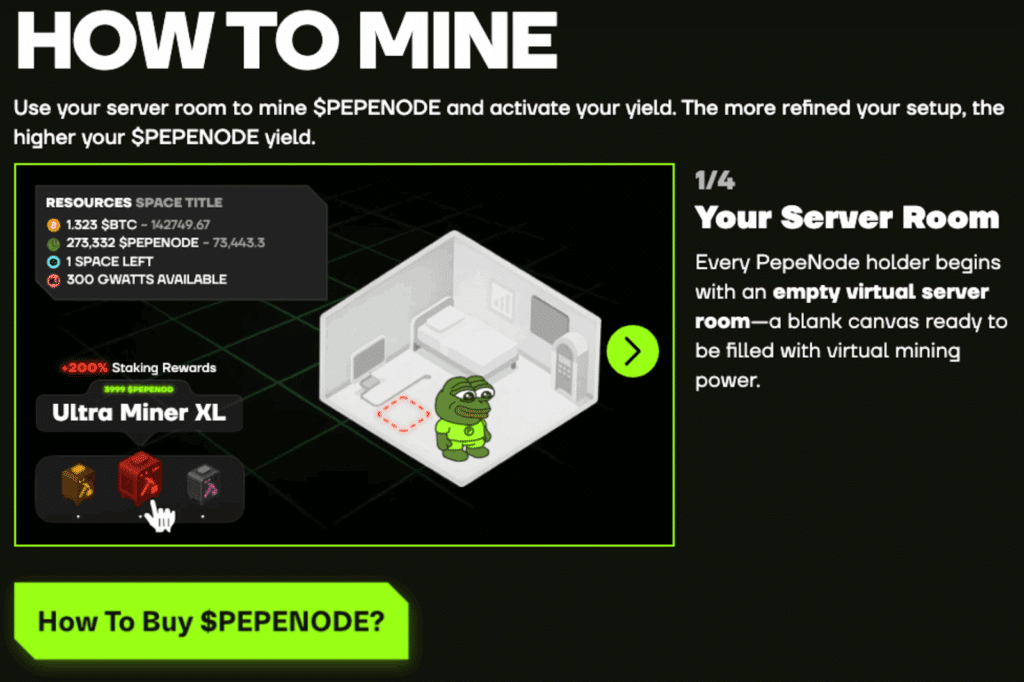KuCoin’s entry into the mining pool sector has revived interest in crypto mining, even as virtual mining innovations like Pepenode reshape how everyday users earn rewards in a fast-evolving Web3 landscape.
Crypto mining is moving back into the spotlight. KuCoin, one of the world’s largest crypto exchanges, has now launched KuPool – a mining pool service that brings Dogecoin, Litecoin, and eventually Bitcoin mining directly into its ecosystem. The move signals a renewed push toward decentralised mining participation and a more equitable distribution of hash power worldwide.
Yet, while major exchanges lean into physical infrastructure, a parallel trend is gaining ground: virtual mining through blockchain gaming.
KuPool is designed to serve newcomers and professional miners alike. Its rollout starts with support for mainstream proof-of-work (PoW) and merged mining assets, including DOGE, LTC, and BELLS, with BTC integration to follow soon. The company claims that KuPool will prioritise transparency, low-latency operations, and fair reward distribution – positioning “verifiable hash rate” as its key trust asset.
Chris Zhu, head of KuPool, said the service integrates deeply with KuCoin’s existing KuMining suite, providing users with straightforward access to a previously complex discipline. The platform introduces a traceable profit-sharing mechanism and real-time auditing to mitigate the information asymmetry that has historically plagued mining pools.
In Zhu’s view, this approach “transforms hash rate into credible assets and ensures global miners receive fair, secure rewards.” KuCoin hopes the service will achieve high hash rates, consistent yields, and strong long-term user retention.
This development comes at a time when crypto mining is facing regulatory pressure across multiple regions. In the United States, New York lawmakers recently proposed tax legislation targeting proof-of-work mining operations, imposing steep fees based on electricity use. Yet despite such challenges, KuCoin sees mining as a key driver of fairness and independence within the crypto ecosystem and believes renewed innovation can help restore trust in decentralised energy incentives.
Virtual Mining Emerges as a Rival to Traditional Infrastructure Models
While KuCoin strengthens its physical mining capabilities, a growing segment of Web3 users is turning to “virtual mining” – a gamified model in which mining rewards are simulated rather than generated by hardware. With high electricity costs and industrial-scale server farms pricing casual miners out of participation, this new framework creates an opportunity for anyone with a smartphone or browser.
The meme coin market provides a clear example of how demand for innovation is shaping user behaviour. After a sudden crash earlier this month, the meme sector is still valued at around $55 billion, down from $67 billion before the drop.
Traders now look for tokens that offer more than viral branding. Utility-focused PoW assets like Dogecoin and experimental tokens such as MemeCore continue to attract buyers, but the most rapid surge in excitement is taking place in gaming-based mining platforms where users can earn rewards without owning expensive hardware.
That is where Pepenode is emerging as a standout contender.
Pepenode Reinvents Crypto Mining – No Hardware Required
Pepenode is currently one of the fastest-growing crypto presale projects, attracting the attention of traders, gaming communities, and Web3 content creators. Its “Mine-to-Earn” model allows users to build virtual mining farms in a browser-based environment, eliminating the high start-up costs of physical crypto mining.
Instead of GPUs and ASIC rigs, users collect and upgrade digital “Meme Nodes” that generate Pepenode tokens and well-known meme assets like PEPE and FARTCOIN. The more powerful the nodes, the higher the mining output. Leaderboards reward top community miners with additional incentives, establishing a competitive and entertaining ecosystem.
This approach offers a playful entry point into crypto mining without facing the technical barrier of configuring hardware or sourcing cheap electricity. Each mining decision – upgrades, expansions, reinvestment – becomes a strategic move in a gaming economy directly connected to real token value.
Pepenode has already become a favourite among whales and presale specialists, raising nearly $2 million as investors anticipate mainstream adoption of virtual mining. It shows that crypto mining can be both accessible and interactive, opening revenue opportunities for users previously locked out of traditional proofs-of-work.

Mining Meets Gaming: Why Analysts Think Pepenode Could Lead the Next Frontier
Well-known crypto commentators have pointed to Pepenode’s incentive structure and gameplay loop as a potential paradigm shift. KIFS Crypto, a reviewer with more than 70,000 subscribers, claims Pepenode “could change meme coins forever” by turning miners into active participants rather than passive asset holders.
The staking rewards offered by Pepenode are also exceptionally high, with advertised returns reaching 671% APY – though this figure is expected to decline as more users stake and mining capacity scales. Early adopters, therefore, have a clear advantage, reinforcing the FOMO-driven growth often seen during breakout presales.
At a current price of $0.0011138 and with the next adjustment scheduled within hours, the presale mechanics encourage speed, much like KuCoin’s mining pools reward continuous participation. The shared theme is unmistakable: mining is evolving into both a technical and cultural movement.
The Broader Picture: Real-World Mining and Virtual Mining Are Converging
KuCoin’s KuPool and Pepenode are not competing trends – they are complementary visions of what mining can become. Traditional PoW mining continues to secure major networks like Bitcoin and Dogecoin, providing foundational value. Meanwhile, virtual mining experiments like Pepenode bring new participants into the economy without pushing energy grids to the breaking point.
As cryptocurrency adoption spreads globally, mining is shifting from a niche dominated by high-capital operators into a hybrid model where anyone can contribute. From KuCoin’s enterprise-grade hashing innovation to Pepenode’s gamified accessibility, crypto mining is in the middle of its most transformative moment since Bitcoin first appeared in 2009.
KuCoin provides users with direct access to PoW networks and high-trust verification – something institutional miners increasingly require. Pepenode, by contrast, makes mining culturally relevant again, reconnecting it with grassroots Web3 communities looking for the next significant opportunity.
MINING IS CHANGING: GET AHEAD OF THE NEXT WAVE WITH PEPENODE
The surge in activity across both physical and virtual mining signals that demand for decentralised earning mechanisms remains strong despite market fluctuations. Investors searching for alternative revenue models are responding to innovation wherever it appears.
Disclaimer: This report is for informational purposes only and does not constitute financial or investment advice. Crypto investing involves risk. Always conduct independent research before making financial decisions.












